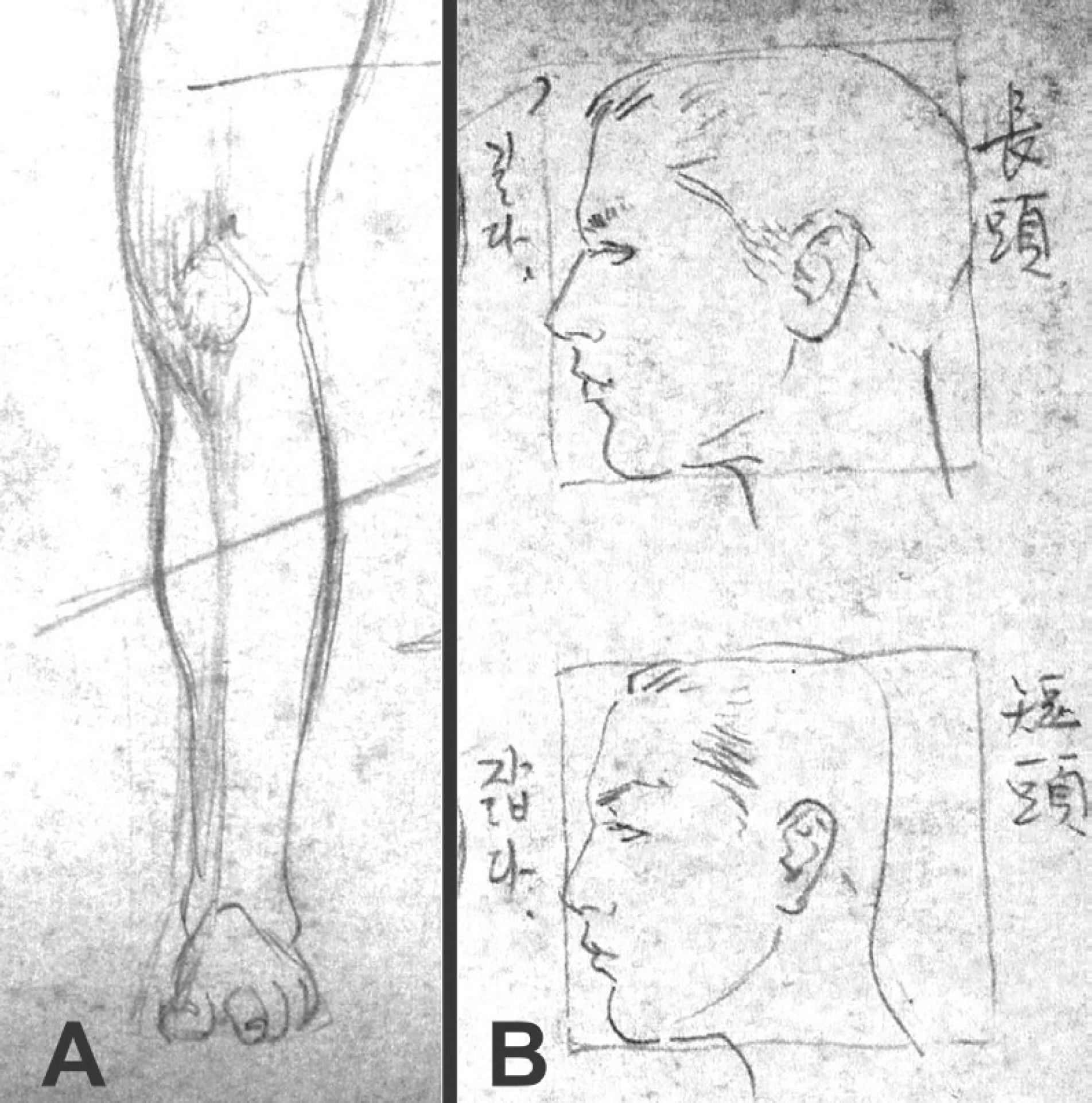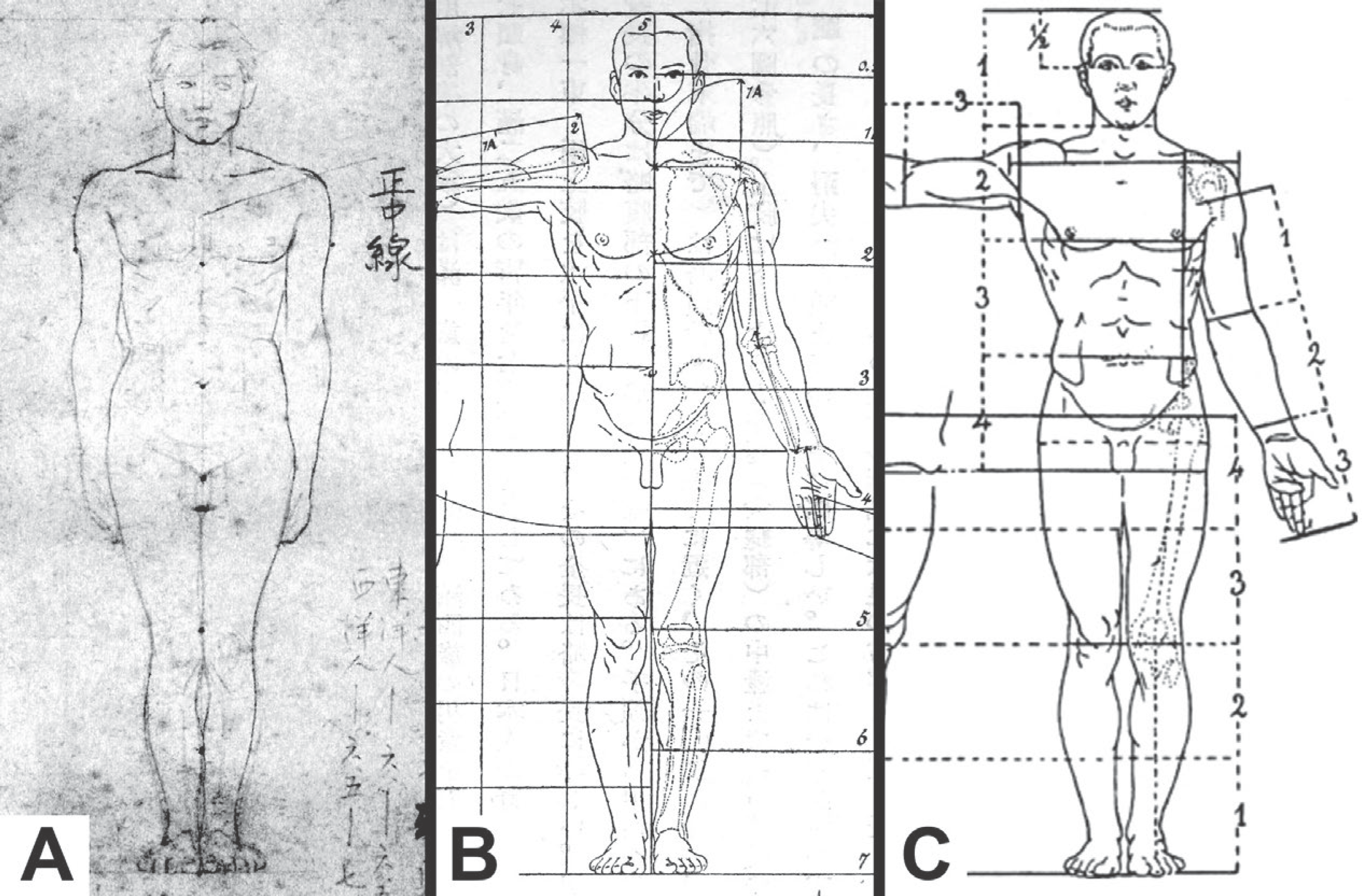Abstract
In 1951, in the midst of the Korean War, artist Lee Quede produced anatomical drawings to teach artistic anatomy to his student Lee Ju-yeong while interned in the Geoje prison camp. Comprising 2 books and spanning over 48 pages, 74 drawings were produced alongside explanations in a textbook format. The table of contents was ordered starting from body proportions, then the skeleton, the muscles, and the head. By part, there were 4 drawings of the trunk, 51 of the head, 7 of the arms, 9 of the legs, and 3 of the full body. Though the drawings of the head and face are both high in number and in detail, there were many errors in his depictions of the bones, and the boundaries between the structures of his muscle drawings were drawn so unclearly as to be indistinguishable. The essential forms, proportions and movement are included, but his disproportionate dedication to the head and the incoherent way that the book is arranged with no relevance to its table of contents leave something to be desired. It is regrettable that Lee Quede's return to North Korea meant that his drawings were not widely used, but despite this, I believe that these are invaluable documents in assessing the influence of Japanese artistic anatomy at the time, as well as the introductory circumstances of Korean artistic anatomy.
Go to : 
References
1. 20th century Korean art questionnaire. Art In Culture. 2015; 2:64–5.
2. National Museum of Modern and Contemporary Art. Lee Quede-An epic of liberation. Dolbegae. 2015.
3. Kim JS, Lee Q. Youlhwadang Publishers an Art Library. 1995.
4. Shin SK. Lee Quede's activities during the liberation period and 〈The Crowd〉series. Art History & Cultural Heritages. 2016; 5:231–60.
5. Kim IH. The study of Lee Quede: Focused on human anatomical drawing book. Eye of era. Hakgojae. 2011. 115–38.
6. Kim H. The Several Aspects of Image Reference in Lee Quede's Painting – Research on the Artist's Archive. The Misulsahakbo: Reviews on the Art History. 2015; 45:191–213.
7. Kim IH. Legacy of Lee Quede – Focusing on Seongbuk Painting Institute (1946∼1950). Monthly Art Magazine: Misulsegae. 2015; 7:78–85.
8. Jung H-M. A study about iconography in Korean modern painting-Religious implications. Korean modern and Contemporary Art History. 1998; 6:339–72.
9. Jeon HS. The Education and Recognition of Occidental Painting of Korea Students in Teikoku Art School-With Focus on Kim Man-Hyung. The Misulsahakbo: Reviews on the Art History. 2004; 22:171–98.
10. Nishida M. Review of art anatomy. Seikisyobou;. 1944.
11. Richer P. Anatomie artistique. Planches;. 1890.
Go to : 
 | Fig. 1.Examples of anatomical error: (A) Floating rib expressed as joining costal arch. (B) The neck of the humerus is drawn incorrectly, like the neck of the femur, while characteristics of the radius and ulna, and the structure of the elbow joint are drawn incorrectly as well. (C) Line of gravity should be further posterior than the hip joint. |
 | Fig. 2.Examples significant to artistic anatomy: (A) The external shape of the calf is well explained, with the medial swelling down-ward and the lateral more upwardly swollen. (B) Anterior-posterior length of head in comparison with that of a Caucasian head. |
 | Fig. 3.Examples of full body proportions: (A) Anatomical of Lee Quede (1951). (B) Arguments on Artistic Anatomy of Masaaki Nishida (1944). (C) Anatomie artistique of Paul Richer (1890). |
Table 1.
Classification of body points in the anatomical drawing of Lee Quede
| Region | Bones | Muscles | Structure | Numbers |
|---|---|---|---|---|
| Body | 2 | 2 | – | 4 |
| Head | 2 | 2 | 47 | 51 |
| Arm | 2 | 2 | 5 | 7 |
| Leg | 3 | 2 | 4 | 9 |
| Whole body | – | – | 3 | 3 |
Table 2.
Numbers of errors in the anatomical drawing of Lee Quede
Table 3.
Anatomically important expressions in the anatomical drawing of Lee Quede




 PDF
PDF ePub
ePub Citation
Citation Print
Print


 XML Download
XML Download